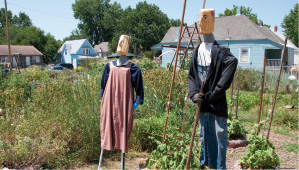
By Leslie Collins
Northeast News
August 8, 2012
Historic Northeast is testing out its green thumb.
As overgrown vacant lots continue to plague Northeast, a number of neighborhoods are opting to transform those lots into community gardens and green spaces.
Community gardening is a trend that’s overtaking Northeast. Several community gardens already exist including Mattie Rhodes’ Jardin Júbilo, Don Bosco Community Garden, St. John Community Gardens, among others.
Northeast resident Rebecca Koop purchased a vacant lot in 2003, which formerly housed a dilapidated industrial building. Now the space at 3922 St. John Ave. serves as a community garden with 10 active community gardeners. St. John Community Gardens also features a rain garden, unconventional scarecrows and other art installations.
Mattie Rhodes transformed a vacant lot at 130 N. Topping. Called Jardin Júbilo, the community garden features a variety of beds with herbs, like chamomile, cilantro and basil, and vegetables, such as tomatoes, peppers, sweet potatoes, corn and others. This year, area residents are renting a plot of their own for $7 for the season.
“We know there’s interest among individuals and families to do this kind of thing,” said Mattie Rhodes’ Director of Community Services Susan Garrett. “Sometimes, they don’t have the space or the ability to build their own bed, so we just want to be able to provide that for them. Plus, we think it’s part of creating a safe, friendly environment in the neighborhood.”
For the Lykins neighborhood, the community garden at 9th and Norton provides more than sustenance.
“I think the community garden has pulled our neighborhood together in a lot of ways,” Lykins Neighborhood Association President Willie Hough said. “It brings people together that I never would have imagined would be brought together. It’s all walks of life and a very diverse group of people in our neighborhood. Everybody’s involved in it.”
Three Northeast neighborhood associations are following Lykins’ lead of establishing a community garden. Both Indian Mound and Pendleton Heights recently received Jackson County Land Trust donations to establish a garden and Sheffield is planning to install a community garden at 12th and Topping.
Located near Hardesty and St. John Avenue, Indian Mound’s future garden is highly visible, Indian Mound Neighborhood Association President Katie Greer said.
“For the last couple of years, it’s (vacant lot) been completely weeded and overgrown. Lots of litter and dumping,” Greer said.
Currently, Indian Mound is applying for grants and soliciting donations from area businesses to establish the garden. Plans include a picnic space with benches as well as a garden.
“There’s definitely a movement of urban renewal and community revitalization,” Greer said. “I think people are starting to care again about what they eat and where it comes from. Being able to grow your own food is just a wonderful thing to have available to us.”
Pendleton Heights plans to create both a community garden and green space gathering place. Pendleton Heights Neighborhood Association President Jessica Ray said the former land trust lots were located at key central locations within the neighborhood.
One of the lots hasn’t housed a building since 1896, she said. Ray wants to preserve Pendleton Height’s history and reinstate the green space.
Several neighbors have volunteered to mow both lots and Ray has already applied for several grants to maintain the garden and green space. Pendleton Heights’ goal is to plant the first round of vegetables next spring.
“I think above all, it just gives something that the community owns together,” Ray said. “Our goal is that they (garden and green space) will continue to bring people together and build some bridges with residents who might not care about official neighborhood business.”
Plans for the green space include park benches, flower pots, a fountain and a fence that says, “Love grows here.”
Mark Morales, president of the Sheffield Neighborhood Association, envisions a community garden that unites families and neighbors.
“We could have three generations of family members adopting a plot in the garden,” Morales said. “It’s family time, family values, something to pull the family together.
“I just want to pull people together and use it as a tool for neighbors to know their neighbors.”
Eventually, Morales would like to see the future community garden become a source of income for area residents by selling the produce at farmers markets.
For Greer, turning a vacant lot into a community garden will send a positive message to the neighborhood and to those driving through.
“I hope it will be inspirational,” she said. “Hopefully, people will see this and know we can make a change and transform things; we can turn things around.”















